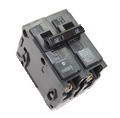|
» Circuit Breakers and Fuses
» Need Electrical Help? Ask the Electrician
Home Circuit Breakers
|
|
By Dave Rongey
Summary: A visual guide to home circuit breakers and the home electrical panel system. © By: Dave Rongey |
Circuit Breakers Commonly Used in the Home Electrical Panels
Home circuit breakers are at the heart of your home electrical power system and are the main component of power distribution for the circuits providing electricity to every area of your home. Home circuit breakers have evolved away from the screw in fuse where they hardly ever wear out and can be simply reset and turned back on in the even of a circuit failure or fault.
Electrical Circuit Breakers and The Electrical Service PanelThe electrical service panel is the power distribution center of the home electrical system. |
|
|
Circuit Breaker Panel The home electrical panel is where the circuit breakers are installed and can be checked or manually turned on or off for when necessary. The home circuit breakers are covered by the service panel cover which serves as a protective barrier to keep unskilled individuals out of the area to avoid the possibility of electrical shock. |
|
|
Labeling Circuit Breakers The circuit breaker panel cover typically has an index which allows labeling or identification of all the installed circuit breakers. Accurate labeling of circuit breakers is extremely helpful when trying to locate the exact circuit breaker that supplies power to a home circuit, device or area of the home. |
|
|
Inside the Electrical Panel Home circuit breakers may be accessed by qualified individuals for testing or servicing as necessary. This area typically has several wires of different colors that identify them for a specific purpose. Each wire is carefully routed to its appropriate location and securely fastened. Keeping the wiring neat and orderly will be very beneficial if extensive work will be required in the future. Wiring should not be too long, or too short, and adjusted as needed depending on the space provided inside the panel. |
|
|
Special Purpose Breakers While each circuit breaker has a specific purpose and assignment, one is the most important of all. This is the Main Circuit Breaker also known as the Main Service Disconnect. This circuit breaker will turn the power off to the distribution area of the electrical service panel. An experienced electrician knows however that even when the main circuit breaker is in the off position that there are still areas of the panel or primary electrical cables leading to the main breaker that will still be energized with live electricity. |
|
|
Power Distribution Depending on the size of the home, several circuit breakers will be found. You will notice that many electricians will identify the circuit cables showing what the circuit will be used for which is very helpful when the panel cover has been removed by the electrician. This makes it easy to trace cables and check the connections for specific wire conductors if needed. This also serves as a convenient way of testing the circuit wiring for voltage or amperage readings. |
|
Applications with Circuit Breakers |
|
Question: Answer: IMPORTANT: NOTE: |
The Safest Way to Test Electrical Devices and Identify Electric Wires!The Non-Contact Electrical TesterThis is a testing tool that I have had in my personal electrical tool pouch for years, and is the first test tool I grab to help identify electrical wiring. It is a Non-contact tester that I use to easily Detect Voltage in Cables, Cords, Circuit Breakers, Lighting Fixtures, Switches, Outlets and Wires. Simply insert the end of the tester into an outlet, lamp socket, or hold the end of the tester against the wire you wish to test. Very handy and easy to use.
The Quickest Way to Check for Faulty Electrical Wiring!The Plug-In Outlet TesterThis is the first tool I grab to troubleshoot a problem with outlet circuit wiring. This popular tester is also used by most inspectors to test for power and check the polarity of circuit wiring. It detects probable improper wiring conditions in standard 110-125 VAC outlets Provides 6 probable wiring conditions that are quick and easy to read for ultimate efficiency Lights indicate if wiring is correct and indicator light chart is included Tests standard 3-wire outlets UL Listed Light indicates if wiring is incorrect Very handy and easy to use.
Strip Off Wire Insulation without Nicking and Damaging the Electric Wire!The Wire Stripper and Wire CutterMy absolute favorite wire stripping tool that I have had in my personal electrical tool pouch for years, and this is the tool I use to safely strip electrical wires. This handy tool has multiple uses: The wire gauges are shown on the side of the tool so you know which slot to use for stripping insulation. The end of the tool can be used to grip and bend wire which is handy for attaching wire onto the screw terminals of switches and outlets.. The wire stripper will work on both solid and stranded wire. This tool is Very Handy and Easy to Use. |
||
Circuit Breakers, Panels, Parts and AccessoriesCircuit Breaker Siemens ITE Circuit Breaker ITE GFCI Circuit Breaker ITE AFCI Circuit Breaker Square D Hot Tub Panel Sub Panel 120 240volt 100amp Sub Panel 120 240volt 125amp Panel 120 240volt 200amp |















